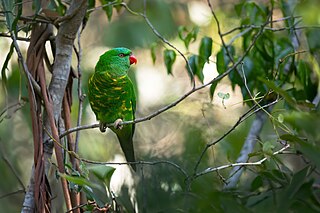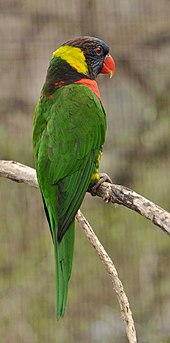
Loriinae is a subfamily of psittacine birds, one of the six subfamilies that make up the family Psittaculidae. It consists of three tribes, the lories and lorikeets (Loriini), the budgerigar (Melopsittacini) and the fig parrots (Cyclopsittini), which are small birds, mostly of bright colors and inhabitants of Oceania and the islands of Southeast Asia.

The yellow-crested cockatoo also known as the lesser sulphur-crested cockatoo, is a medium-sized cockatoo with white plumage, bluish-white bare orbital skin, grey feet, a black bill, and a retractile yellow or orange crest. The sexes are similar.

The scaly-breasted lorikeet is an Australian lorikeet found in woodland in eastern Australia. The common name aptly describes this bird, which has yellow breast feathers broadly edged with green that look like scales.

The rainbow lorikeet is a species of parrot found in Australia. It is common along the eastern seaboard, from northern Queensland to South Australia. Its habitat is rainforest, coastal bush and woodland areas. Six taxa traditionally listed as subspecies of the rainbow lorikeet are now treated as separate species.

The Australian ringneck is a parrot native to Australia. Except for extreme tropical and highland areas, the species has adapted to all conditions. Treatments of genus Barnardius have previously recognised two species, the Port Lincoln parrot and the mallee ringneck, but due to these readily interbreeding at the contact zone they are usually regarded as a single species B. zonarius with subspecific descriptions. Currently, four subspecies are recognised, each with a distinct range.

The red-collared lorikeet is a species of parrot found in wooded habitats in northern Australia. It was previously considered a subspecies of the rainbow lorikeet, but today most major authorities consider them as separate species. No other member of the rainbow lorikeet group has an orange-red collar over the nape.

A feral parrot is a parrot that has adapted to life in an ecosystem to which it is not native. The birds are often descended from pets that have escaped or been deliberately released. Many species of parrots are highly social, and like to gather in large flocks. Not all feral parrots are able to adapt to life outside of captivity, although having a pre-existing nearby parrot colony can assist with the adaptation process.

The red-and-blue lory is a small, strikingly-colored parrot endemic to Indonesia. The species inhabits a single island, Karakelong, in the Indonesian archipelago, although it was formerly found on the Sangihe Islands and other parts of the Talaud Islands.

The varied lorikeet, is a species of parrot in the family Psittacidae that is endemic to the northern coastal regions of Australia. It is the only species in the genus Psitteuteles.

The olive-headed lorikeet, also called the perfect lorikeet, is a species of parrot in the family Psittaculidae. It is found in forest, woodland and cultivated areas on Timor and smaller nearby islands.

The Sula lorikeet is a species of parrot in the family Psittaculidae. It is endemic to the Sula Islands in Indonesia. It is found in forest and woodland at altitudes up to 2400 m. It is generally common.

The ornate lorikeet, sometimes named the ornate lory, is a species of parrot in the family Psittaculidae. It is endemic to the Sulawesi archipelago in Indonesia. It is found in forest, woodland, mangrove and plantations, and is locally common.

The elegant pitta is a species of passerine bird in the pitta family Pittidae. It is endemic to Indonesia, where it is found in the Lesser Sunda Islands and Moluccas.

The marigold lorikeet or Sumba lorikeet is a species of parrot that is endemic to the south-east Asian islands of Sumba, Rote, Wetar and Kisar (Indonesia) and Timor. It was previously considered a subspecies of the rainbow lorikeet, but following a review in 1997, it is increasingly treated as a separate species.

The leaf lorikeet, also known as the Flores lorikeet or Weber's lorikeet, is a species of parrot that is endemic to the Indonesian island of Flores. It was previously considered a subspecies of the rainbow lorikeet, but following a review in 1997, it is increasingly treated as a separate species.

The Lesser Sundas deciduous forests is a tropical dry forest ecoregion in Indonesia. The ecoregion includes the islands of Lombok, Sumbawa, Komodo, Flores, and Alor, along with the many adjacent smaller islands.

The rusty-breasted whistler, also known as the fulvous-tinted whistler, is a species of bird in the family Pachycephalidae. It is endemic to Indonesia, where it ranges from Java east to Alor and north to the Selayar Islands.

The coconut lorikeet, also known as the green-naped lorikeet, is a parrot in the family Psittaculidae. Seven species of lorikeets now recognised were once lumped together under Trichoglossus haematodus.



















